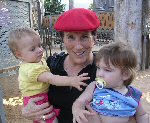
The Human Spirit: Women and Hannukah
December 06, 2007
When I was a little girl in Connecticut, my Hebrew school teacher explained that while the Maccabee men fought against the Syrian-Greeks and their elephants, the Maccabee women were quickly frying latkes between battles. Hence women also had a special connection to the Festival of Lights.
Looking back, I can imagine the rather bashful newly minted Orthodox rabbi deciding to skip the other prevailing women's stories connected to Hanukka. How could he possibly have explained the story of the bold Maccabee sister, not the heralded brothers, for sparking the revolt against the Syrian-Greeks? The Maccabee bride allegedly made a scene, an immodest one, publicly accusing her male family members of cowardice in not fighting back when the rulers demanded droit de seigneur - the right of a governor to defile a bride on the night before her wedding.
Likewise, I'm sure our rabbi knew the story in the Apocrypha of the heroism of Judith, who provided a soporific dinner for General Holofernes and then cut off his head, saving her people. He would have had trouble with the "going to the tent" part.
Nonetheless, it is in the militant feminist Judith's honor that we eat dairy meals and that women refrain from work while the Hanukka candles burn. That's an intriguing obligation/perk. But what exactly constitutes "work" while the candles burn? What about those latkes? To fry or not to fry, that is the question.
The answer depends on whom you ask.
Okay - I know that serious halachic questions should be decided with the help of a rabbi. But latkes seems to me one of those meta-halachic questions that you might be able to figure out without phoning your decisor. So I turned to two new books in my personal library to see how they direct woman's obligation in the Festival of Lights.
The first, a recently published slim paperback, is called Shaare Simcha or Gates of Joy. It's actually an expanded bencher - the booklet which combines the blessing after eating with songs and other useful texts. These are often the felicitous souvenirs of weddings and bar/bat mitzvas, and here's one I would happily choose.
Gates of Joy was created by Adena Berkowitz and Rivka Haut. Berkowitz is an Orthodox educator and Haut an Orthodox rabbanit (in her case, this word means both "rabbi's wife" and "rabbinic scholar") and the well-known pioneering campaigner for unchaining Jewish women unable to divorce. The book supplies insights where your average bencher falls short in terms of addressing women's ritual observance and providing fascinating sources and customs.
FOR EXAMPLE, I first used it on Succot, when there's a custom of hospitality to invite in the spirits of Jewish heroes of the past. The matriarchs and prophetesses always seemed conspicuous by their absence. In Gates of Joy, the text for both the ushpizot and ushpizin was included.
On Hanukka, Gates of Joy provides a useful summary of the holiday, its obligations and traditions. A woman's need to light candles is clear. The holiday laws and customs are appended with a useful list of suggested educational outreach and acts of kindness that can be increased for the holiday. The theme of working toward family harmony, for example, is an old Hanukka tradition noted in this handy book.
Then I checked in my recently purchased ArtScroll Women's Siddur Ohel Sarah. I admit that I purchased one despite the sharp warning against it circulated by the Jewish Orthodox Feminine Alliance, an organization with which I identify. Many valid points have been made by other writers in regretting the decisions made by the authors of this siddur, such as their discouraging women from saying Birkat Hagomel, or saying Kaddish. Nor would I buy it for a Hebrew school girl who might treat it as an ultimate source and who might not yet understand that ArtScroll, like every publisher, has its point of view.
I was drawn by the many interesting references to coping with interruptions or running late - issues that continue to challenge me even though my children have grown up. Plus there are suggestions for certain new conundrums. For example, what to do if you light Shabbat candles and then arrive at synagogue in time for the weekday minha prayer? For you it is already Shabbat. Before I started praying regularly at Shira Hadasha, a congregation where the hundreds of seats in both the women's section and the men's section are filled by Kabbalat Shabbat, I rarely made it to synagogue by minha.
In its notes on Hanukka, the ArtScroll Women's Siddur affirms the obligation of women to light Hanukka candles. Publicizing the miracle of Hanukka by candlelighting isn't a time-bound mitzva that women, no matter how busy, can skip.
Married women? "Generally" it says, a married woman says amen to her husband's blessing. (Why not do this together?) Then it provides for a list of realistic "special cases." If a husband is away or coming home very late - yes - go ahead and light while the kids are up. There are tips on what to do if you're a guest at someone else's house or away on a business trip.
My childhood rabbi may have hedged on some of the Hanukka stories, but he was definite about little girls lighting - a seminal religious experience for my sister and me.
Although Gates of Joy includes cooking in the work that women avoid while the candles are lit, here the ArtScroll Women's Siddur is, well, rather "liberal." Women and girls are allowed to chop, fry and serve in the kitchen while the candles burn.
Thinking of the theme of family harmony, we're serving the oven-baked low-fat latkes this year: You get them ready ahead of time.
Wherever you're lighting, Hanukka sameah. May we all be privileged to publicize miracles of our people in Jerusalem.
